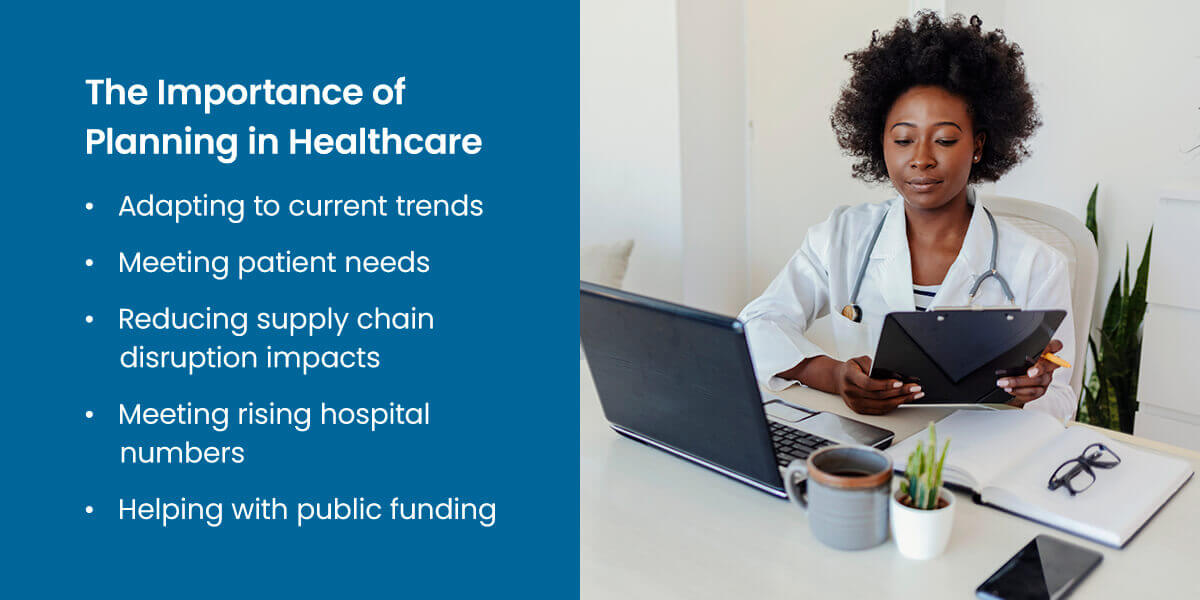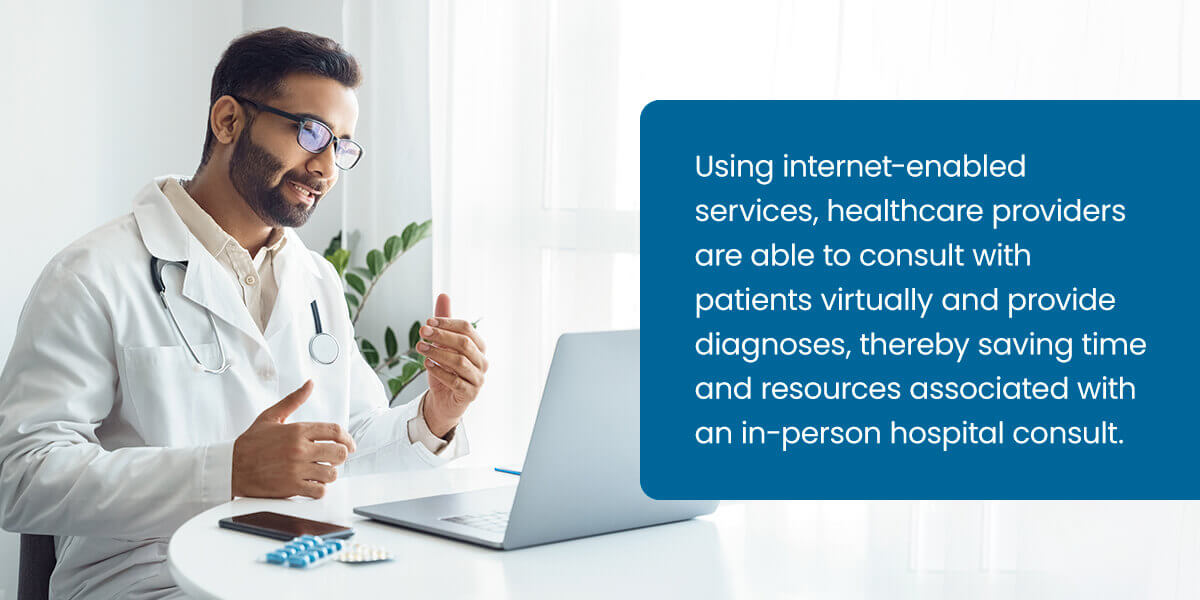Healthcare institutions around the world must adapt their strategies to meet current trends and patient preferences. By using reliable and thoughtful planning, healthcare facilities can initiate patient-centric approaches and boost success.
Strategic healthcare planning consists of creating objectives, setting goals and then creating a plan for achievement. In other words, it’s the process of outlining goals and taking the necessary steps to achieve them. Most healthcare plans also consider government policies and technological advancements that could alter health goals and operations.
Read on to learn more about the importance of planning in healthcare.
In This Article
- The Importance of Planning in Healthcare
- Top 5 Strategic Challenges in Healthcare
- The Benefits of Healthcare Strategic Planning
- Questions to Ask
- Partner With AchieveIt Today
The Importance of Planning in Healthcare

Strategic planning is essential for a healthcare facility’s overall success. Planning allows organizations to adjust to the changing demands of the healthcare industry while supporting goal achievement.
You can also see the importance of strategic healthcare planning in other areas, including:
- Adapting to current trends: Having strong plans in place can help your facility adjust to current trends. By strategically thinking about the future of the field, you can avoid surprises later. For example, a significant change facing the healthcare industry is the rise of hybrid and remote work. Many facilities offer telehealth services or remote appointments for patients. With strategic management in healthcare, institutions can take note of these changes and adjust upcoming hiring policies and staff positions.
- Meeting patient needs: Strategic planning can also aid facilities in meeting patient needs. As technological advancements progress and the number of available providers grows, patients are seeking personalized and high-quality options. Facilities can examine patient demands and use these to craft their upcoming strategy in healthcare. In turn, they can create a patient-centric approach that improves the quality of care and sets them apart from competitors.
- Reducing supply chain disruption impacts: The COVID-19 pandemic disrupted the supply chain for all industries, including healthcare. Without the proper tools and equipment, healthcare professionals cannot provide care for all patients. Your strategic plan could help you analyze current supply chain trends and alter ordering decisions in response. For instance, if you notice a specific type of equipment is consistently out of stock, you could order extra quantities for your facility.
- Meeting rising hospital numbers: After the COVID-19 pandemic, the healthcare industry experienced a sudden increase in hospitalizations. Strategic planning allows facilities to allocate necessary resources to meet these trends. They can also become more prepared for other potential health crises.
- Helping with public funding: Strong performance helps healthcare facilities receive more funding from public sources. Most donors use various quality metrics to determine how much funding institutions should gain each year. A strategic plan can boost your facility’s performance on many levels, from care quality to maintaining supplies.
Overall, strategic planning in hospitals and other facilities is essential for institutional success and responding to current trends in the healthcare industry.
Top 5 Strategic Challenges in Healthcare
From the Affordable Care Act’s (ACA) influx of insured patients to the increased strain of COVID-19, healthcare facilities have been constantly adapting. Here are some examples of strategic planning in healthcare today.
1. New Technologies

In the medical field, new technologies seem to appear every day. From remote patient monitoring to robust patient portals, healthcare facilities must consider the evolution of the tools used during day-to-day care. These resources may impact workflows, budgets and the patient experience.
Many new technologies offer benefits like improved efficiency and positive experiences, but they can also create healthcare challenges in the form of new requirements for your IT team and staff training. Remaining flexible can help you accommodate these possibilities, stay ahead of the competition and improve care with modern capabilities.
2. Mass Adoption of Virtual Care

From a cost perspective, one shining light for healthcare systems is the rise of virtual care, commonly referred to as telemedicine. Using internet-enabled services, healthcare providers are able to consult with patients virtually and provide diagnoses, thereby saving time and resources associated with an in-person hospital consult.
As this technology continues to proliferate, and patients become more comfortable with interacting with their doctors over virtual systems, healthcare systems will be able to trim significant expenses across departments, helping to control costs. In creating their strategic plans, healthcare leaders should take a deep look at how they continue managing telemedicine technology to help aid in future cost savings.
3. Continued Management of Cybersecurity Risks
Data security has become a significant challenge across industries, but none more so than the healthcare industry. Due to the extensive nature of personal information inherent in healthcare records, insurance companies and healthcare systems should be cautious regarding the security of their patient records.
As regular security breaches always remind us, healthcare entities should pay special attention to the security of their systems to ensure the privacy of subscribers. Healthcare leadership will need to collaborate extensively with IT, in a strategic sense, to ensure the department has the resources and technology necessary to guarantee data security and HIPAA compliance.
4. Evolving Coding Requirements

The next version of the International Classification of Diseases (ICD) is currently under review in the U.S. If you’ve been in the industry for a while, you might remember the transition to ICD-10 back in 2015. Although we may not see ICD-11 for a while, healthcare strategy must consider this eventual implementation and other potential changes to reporting and documentation requirements. To ensure full reimbursement, organizations may need to upgrade existing systems and train employees accordingly.
5. Population Health Management
Healthcare systems across the country are being confronted with a new paradigm of healthcare delivery: Ensuring the overall health of demographic cohorts within their communities.
Shifts toward value-based care only increase the focus on population health, requiring healthcare leaders to design strategic plans and allocate resources to educate the populations they serve on preventative care. This will require the participation of stakeholders across departments and often will necessitate new programs to be established to help further population health interests.
The Benefits of Healthcare Strategic Planning

Committing to a strategic plan can bring many benefits to healthcare facilities, including:
- Establishing a shared vision: A plan requires your facility to focus on specific goals. As you develop these objectives, you and your team can establish the overall purpose of your facility. Then, you can create concrete ways to meet this vision. You can also inform employees, shareholders and other crucial team members of this vision, inspiring members at every level. All members can unite around a shared purpose and find more value in their work, improving overall performance.
- Prioritizing critical issues: By focusing on a strategic plan, you can prioritize vital issues. Every healthcare facility has specific areas for improvement, whether it’s improving collaboration or meeting staffing requirements. Strategic management in healthcare allows you to identify these areas and brainstorm specific ways to address them. You can focus on resolving the most significant issues first, instead of getting overwhelmed with secondary problems.
- Improving team communication: Strategic planning also assists with communication across your facility. Your plan should address key issues and goals, then outline the steps you will take to achieve these. You can share these plans with all institutional members, giving everyone a clear idea of future actions. With everyone on the same page, your facility can collaborate more easily and stay on track with goals.
- Enhancing motivation: A clear vision and plan can motivate employees to work harder. They can feel empowered to make decisions that support institutional goals. As they work toward a shared purpose outlined in a healthcare strategy, they feel more motivated by their daily work and can improve their performance.
- Solidifying leadership: All healthcare facilities rely on strong leadership to lead employees and meet goals. Leaders can use strategic plans to clearly identify goals for employees. They can clarify expected behaviors and encourage employees to work toward their personal best. Passionate leaders and hard-working employees can establish your facility as a leading healthcare option.
Questions to Ask
Because the purpose of strategic planning in healthcare is to work towards improvement, asking questions can help you. Healthcare institutions should ask a few crucial questions during their planning. By thinking about particular circumstances, you can tailor plans for your needs. These questions can also help you identify goals and develop a shared purpose.
Here are a few examples of questions to ask during strategic planning:
- What is the current financial situation of your institution?
- What are your goals for finances moving forward?
- What areas need more help or growth?
- What are the needs of your facility’s typical population?
- How could these needs change over time?
- What current trends in the healthcare industry or government policies could impede these goals?
- Where would you like to see your organization in five years or ten years?
You can use questions like these to establish objectives and an overall vision. Once you have developed these, you can develop steps for achievement. Structures like SMART goals can help you create measurable and timely actions.
Partner With AchieveIt Today
At AchieveIt, we understand the importance of well-defined healthcare goals and addressing the challenges of healthcare strategy. You can move directly toward your shared vision with a strategic plan and clear-cut goals.
Our strategic planning software helps healthcare institutions meet their goals. The technology helps you analyze data to identify specific goals and areas for improvement. Then, we can help you form quantifiable and actionable goals that move you toward your overall purpose.
AchieveIt software also features:
- Integrated reports
- Automated reminders for deadlines and goals
- Real-time data updates
- Speedy set-ups and communication processes
Our expert team of specialists can help your facility through each step of the planning process. We can enhance your plans and offer specific suggestions for improvement. Whether you want to improve physician care or reduce waiting room times, our software can help you meet these goals.
Let’s actually do this. Schedule a demo with AchieveIt today.




